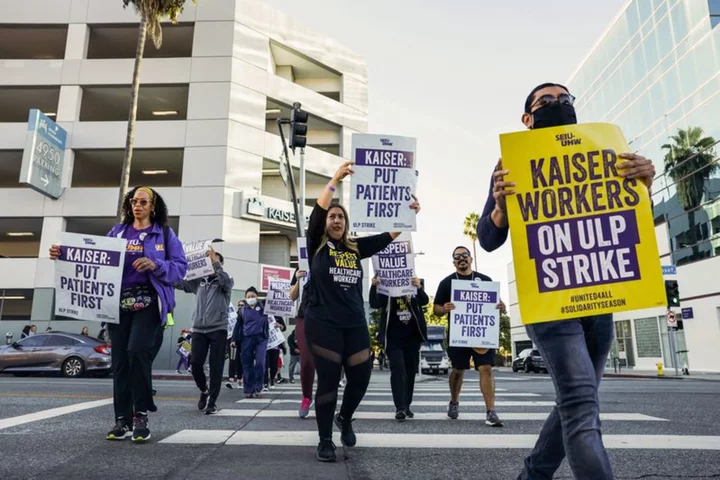By Leroy Leo and Bhanvi Satija
About 75,000 medical workers from Kaiser Permanente facilities went on a planned three-day strike on Wednesday, putting pressure on one of the leading not-for-profit U.S. healthcare networks to reach an agreement on a new contract.
It is the largest walkout ever in the U.S. healthcare sector, surpassing a 53,000-person strike in 2018. It stems from staffing shortages plaguing the sector, largely a consequence of occupational "burnout" from the COVID-19 pandemic.
Here's what you need to know.
WHAT ARE KAISER WORKERS' DEMANDS AND WHAT IS THE COMPANY OFFERING?
Some of the key demands by the workers include higher pay to keep up with the cost of living, a $25-per-hour minimum wage for all healthcare workers, and a reformed bonus structure.
Kaiser has offered across-the-board wage increases of 12.5% to 16% over four years, but unions call the offer unacceptable and inadequate to meet the "skyrocketing cost of living".
WHY ARE WORKERS WORRIED ABOUT STAFFING LEVELS?
More than 5 million U.S. medical workers left their jobs during the pandemic, causing an acute staffing crunch across the sector and leaving employees that stayed behind feeling overworked and underpaid.
The union insists Kaiser needs to hire 10,000 new healthcare workers to fill current vacancies, as well as "fix broken hiring processes" that are preventing full staffing.
In January, about a third of the nurses in the United States were considering leaving their profession after the pandemic left them overwhelmed and fatigued, according to a survey of over 18,000 nurses conducted by AMN Healthcare Services.
The unions are asking Kaiser Permanente to make massive investment in the education and training of future healthcare workers, and for a diminished role for vendors and third-party contractors that the healthcare network relies on.
HOW WILL THIS NEGOTIATION AFFECT THE SECTOR?
Kaiser is one of the largest U.S. medical employers, with 68,000 nurses, 213,000 technicians, clerical workers, and administrative staff, and its 24,000 doctors. It serves about 13 million people in eight states and the District of Columbia.
The company's workforce is one of the better paid in the country, but over the last decade, lower-wage workers have seen an erosion in their standard of living and purchasing power, said John August, program director of healthcare labor relations at Cornell's School of Industrial and Labor Relations.
"Anything Kaiser does has a massive impact on the market," said Russ Richmond, co-founder and CEO of healthcare management software provider Laudio. "We will see other health systems receive similar demands from their unions, which will undoubtedly be on the wage front, but also on job duties."
WILL THERE BE MORE STRIKES?
Nurses and other medical workers at 11 Tenet Healthcare facilities across California recently voted to authorize a strike later this month to spur negotiations around wages and staffing.
Last month, more than 500 dialysis caregivers went on strike at nearly two dozen Satellite Healthcare and Fresenius Kidney Care clinics across California over unfair labor practices.
Unions across the United States, including in the media and automotive industries, have gone on strike for better working conditions and wages, with 2023 on track to become the busiest year for strikes since 2019.
(Reporting by Leroy Leo and Bhanvi Satija in Bengaluru, and Ahmed Aboulenein in Washington D.C.; Editing by Shinjini Ganguli)









